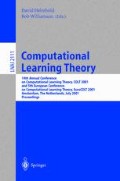Abstract
A boolean perceptron is a linear threshold function over the discrete boolean domain 0, 1 n. That is, it maps any binary vector to 0 or 1 depending on whether the vector’s components satisfy some linear inequality. In 1961, Chow [9] showed that any boolean perceptron is determined by the average or “center of gravity” of its “true” vectors (those that are mapped to 1). Moreover, this average distinguishes the function from any other boolean function, not just other boolean perceptrons. We address an associated statisticalquestion of whether an empirical estimate of this average is likely to provide a good approximation to the perceptron. In this paper we show that an estimate that is accurate to within additive error (ε/n)O(log(1/ε)) determines a boolean perceptron that is accurate to within error ε (the fraction of misclassified vectors). This provides a mildly super-polynomial bound on the sample complexity of learning boolean perceptrons in the “restricted focus of attention” setting. In the process we also find some interesting geometrical properties of the vertices of the unit hypercube.
Access this chapter
Tax calculation will be finalised at checkout
Purchases are for personal use only
Preview
Unable to display preview. Download preview PDF.
References
M. Anthony and P.L. Bartlett (1999). Neural Network Learning: Theoretical Foundations, Cambridge University Press, Cambridge.
M. Anthony, G. Brightwell and J. Shawe-Taylor (1995). On Specifying Boolean Functions by Labelled Examples. Discrete Applied Mathematics 61, pp. 1–25.
S. Ben-David and E. Dichterman (1998). Learning with Restricted Focus of Attention, J. of Computer and System Sciences, 56(3), pp. 277–298. (earlier version in COLT’93)
S. Ben-David and E. Dichterman (1994). Learnability with restricted focus of attention guarantees noise-tolerance, 5th International Workshop on Algorithmic Learning Theory, pp. 248–259.
A. Birkendorf, E. Dichterman, J. Jackson, N. Klasner and H.U. Simon (1998). On restricted-focus-of-attention learnability of Boolean functions, Machine Learning, 30, 89–123. (earlier version in COLT’96)
A. Blum, A. Frieze, R. Kannan and S. Vempala (1998). A Polynomial-time Algorithm for Learning Noisy Linear Threshold Functions. Algorithmica 22: pp. 35–52.
A. Blumer, A. Ehrenfeucht, D. Haussler and M.K. Warmuth (1989). Learnability and the Vapnik-Chervonenkis Dimension, J.ACM 36, 929–965.
J. Bruck (1990). Harmonic analysis of polynomial threshold functions. SIAM Journal of Discrete Mathematics, 3(2), 168–177.
C.K. Chow (1961). On the characterization of threshold functions. Proc. Symp. on Switching Circuit Theory and Logical Design, 34–38.
E. Dichterman (1998). Learning with Limited Visibility. CDAM Research Reports Series, LSE-CDAM-98-01 44pp.
M.E. Dyer, A.M. Frieze, R. Kannan, A. Kapoor, L. Perkovic and U. Vazirani (1993). A mildly exponential time algorithm for approximating the number of solutions to a multidimensional knapsack problem. Combinatorics, Probability and Computing 2, 271–284.
T. Eiter, T. Ibaraki and K. Makino (1998). Decision Lists and Related Boolean Functions. Institut Für Informatik JLU Giessen (IFIG) Research Reports 9804.
P.W. Goldberg (1999). Learning Fixed-dimension Linear Thresholds from Fragmented Data. Warwick CSdept. tech. report RR362, Sept. 99, accepted for publication in Information and Computation as of Dec. 2000. A preliminary version is in Procs of the 1999 Conference on ComputationalLearning Theory, pp. 88–99 July 1999.
P. Kaszerman (1963). A geometric test-synthesis procedure for a threshold device. Information and Control 6(4), 381–398.
N. Littlestone (1988). Learning Quickly When Irrelevant Attributes Abound: A New Linear-threshold Algorithm. Machine Learning 2, pp. 285–318.
R.L. Rivest (1996). Learning Decision Lists. Machine Learning 2 pp. 229–246.
F. Rosenblatt (1962). Principles of Neurodynamics. Spartan Books, New York, 1962.
R.O. Winder (1969). Threshold Gate Approximations Based on Chow Parameters. IEEE Transactions on Computers 18, pp. 372–5.
R.O. Winder (1971). Chow Parameters in Threshold Logic. Journal of the ACM 18(2), pp. 265–89.
Author information
Authors and Affiliations
Editor information
Editors and Affiliations
Rights and permissions
Copyright information
© 2001 Springer-Verlag Berlin Heidelberg
About this paper
Cite this paper
Goldberg, P.W. (2001). Estimating a Boolean Perceptron from Its Average Satisfying Assignment: A Bound on the Precision Required. In: Helmbold, D., Williamson, B. (eds) Computational Learning Theory. COLT 2001. Lecture Notes in Computer Science(), vol 2111. Springer, Berlin, Heidelberg. https://doi.org/10.1007/3-540-44581-1_8
Download citation
DOI: https://doi.org/10.1007/3-540-44581-1_8
Published:
Publisher Name: Springer, Berlin, Heidelberg
Print ISBN: 978-3-540-42343-0
Online ISBN: 978-3-540-44581-4
eBook Packages: Springer Book Archive

